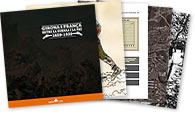Girona and France. Times of war and peace, 1659-1939
The 1808-1814 Peninsular War (or Spanish War of Independence) was a particularly cruel and dramatic moment in the relationship between France and Girona (and also Catalonia and the rest of Spain). However, it must be admitted that the links between the people of Girona and their northern neighbours were considerably more complex over the whole 1659-1939 period. Times of war and times of peace followed in succession during these three centuries that constitute the recent past of present-day Girona.
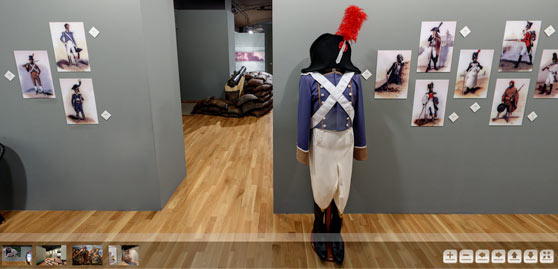
Click on the image to view the interactive, 360 degree panoramic photographs
Girona and France in the making of modern Europe (1659-1823)
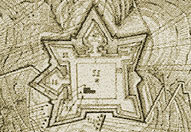
The history of Girona province over the last 350 years has been constantly marked by France. The French allied with the Catalans in the 1640-1659 Reapers' War (or Catalan War of Secession), at the end of which the Spanish monarchy ceded Roussillon and Cerdagne counties to France, as part of an attempt to retain its hold on the Netherlands. This meant that the new border was now fifty kilometres closer to Girona, which in turn obliged the monarchy to replace the old 15th-century fortress at Salses (Roussillon) with new fortifications within Catalan territory at Roses, Figueres and Montjuïc. From that moment on, the Girona area would be the primary battlefield in the event of further conflict between Spain and France.
Daily life in peacetime and wartime
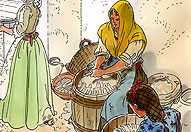
France was the leading player in the wars taking place in the Girona area from the 17th to the 19th century, but also acted a major role in peacetime. In the mainly rural economy of the era, the many factors common to the two Catalonias meant that differences between them were not so great, despite the fact that they belonged to states that were frequently in rivalry with each other. There were numerous cross-border personal and family links, as well as trade and smuggling activity. Furthermore, the Catalan language was maintained on both sides of the border.
Girona under siege
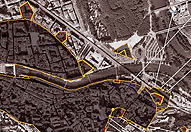
An army unable to confront invaders on the battlefield was wont to take refuge in fortresses and cities in its attempt to hinder the enemy's advance. The invading army would then lay siege to the fortress. However, as the artillery of the age was insufficient to weaken the fortifications and defence walls, sieges often lasted for considerable lengths of time. The will to resist a siege was sustained both by fear of the plunder and murder that might ensue following defeat and by the violence and repression that was meted out for acts of insubordination. Nevertheless, if the besieged did not receive reinforcements, living conditions gradually deteriorated and the capacity to resist was accordingly reduced. This is what occurred during the two long sieges of Girona in 1808 and 1809.
In the early 19th century, Girona was a small city of some 8000 inhabitants, surrounded by medieval defence walls that had been reinforced in the 17th century. Montjuïc fort, built in the 18th century, constituted the city's best defence.
Views of the war
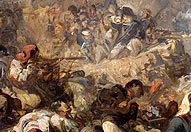
A propaganda war ran parallel to the fighting. The French regarded the besieged as cowards and bandoleers; the besieged saw the French invaders as sacrilegious enemies of religion and the monarch who were prepared to resort to blood and fire in their attack on the city. However, not all Catalans or Spaniards were equally prepared to fight. The allegedly unanimous defence of Girona against the French invasion was one of the most firmly held tenets of the Peninsular War but, in fact, the reality was more complex. Some indeed fought to defend their city but there were others who deserted, fled or went into hiding: not everybody was prepared to give up their life for the sake of king, country or religion.
The patriots and the Frenchified
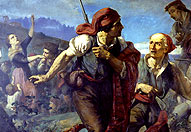
During the war, a cultural and political debate took place on the future organisation of Spanish society. A Frenchified minority aligned with the new French authorities in the hopes of thus obtaining the reforms they considered fundamental for social progress. The patriotic majority opposed the invasion but upheld major differences of opinion on how to proceed once the French had been defeated. On the one hand, the absolutist faction wanted to re-establish the institutions as they were before the invasion; on the other hand, the liberal faction saw the need to introduce reforms, starting with the proclamation of a constitution that would ensure basic individual freedoms and rights.
Memory of the war

From the very beginning, the sieges were subject to interpretation and converted into legend, firstly to support the cause of the resistance and later as a cultural heritage that could be pressed into different types of ideological service. However, although the history of the sieges and, consequently, a certain negative vision of France were to become part of Girona's identity, contacts with the neighbouring country continued as frequently as ever.
Firearms and how they worked during the Peninsular War
Girona and France. Times of war and peace, 1659-1939
Text: Josep Clara, Lluís M. de Puig, Maties Ramisa, Lluís Roure, Enric Sagué and Genís Barnosell. Panoramic photographs: Jaume Llorens. Design of exhibition: 3carme33, Pep Canaleta and Jordi Claveria.
